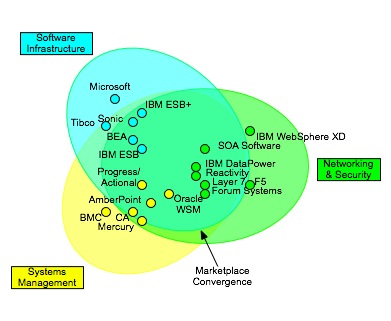 Integration, not convergence
Integration, not convergence
I recently had the opportunity to discuss the positioning of SOA appliances and it caused me to revisit my convergence model, as shown here:

This diagram was intended to show the challenges that enterprise face in choosing vendors today, as there are solutions from multiple product spaces. The capabilities frequently associated with activities “in the middle” can come from network appliances, application servers, ESBs, service management systems, etc. My original post talked about the challenges that organizations face in trying to pick a solution. A key factor that must be weighed is the roles in the organization. My view is that the activities in the middle should beconfigured, not coded. That’s a topic for another post, however.
I started thinking about the future state, and realized that while the offerings from vendors overlap today, that shouldn’t be the long term trend. Even vendors that can cover the entire space do it with multiple products. The right model that we should be shooting for is one that looks like this:

In this model, we have four distinct components. Service hosting is concerned with the development and execution of services. Service connectivity consists of the capabilities in the middle: routing, mediation, etc. Service management provides management facilities over both of these domains. All of these systems rely on a set of information resources which provide both the information to process, as well as the policy and meta-information required for the appropriate execution of the systems. A registry/repository, therefore, would fall into the information resource domain.
What we’d like is for all of these domains to be integrated in an open, standards-based manner. Unfortunately, we’re still a ways off from that day. There have been some proprietary efforts to create integrated solutions that look like this, such as the Governance Interoperability Framework effort by Systinet, but there’s still a long way to go. None of the vendors associated with GIF are the big players in the service hosting space (IBM, BEA, Oracle, Microsoft, etc.), and the integration standards are not open. When we have open, integration standards, we can now begin to create the feedback loop.
One short-term issue that needs to improve is the tight coupling of management consoles to the platforms. In the model, service management is loosely coupled. It integrates with the other domains through loosely coupled services, all of the best practices of SOA. Today, service hosting platforms and service connectivity systems all come with their own management consoles. In order to enable this model, the management architecture of those systems must be built on SOA principles. That means that all of the capabilities that can be managed should be exposed as services. You want to deploy a new application to the application server? Call the application deployment service. This creates a great situation for automated build systems. Out of the box, the build process could be executed in your favorite BPEL engine, with controls for compilation, automated testing, source code tagging, and deployment all orchestrated through web service interactions. Now add in a feedback loop by which metrics cause additional provisioning, or even where an uncaught exception results in a tag being placed on the source files associated with the stack trace to aid in debugging. It all begins with having the services available. Ask your vendors one simple question: are all the capabilities available through the management console also available as services?

Hi Todd,
Good article. I like your vision about the capabilities of the management console as services. I am not aware of that any vendor can actually do it.
Your three models of Service Connectivity, Service Hosting and Service Management are very interesting. Obviously, you like to see an open-standard to cover all three domains. I wonder if you have looked at the Java Business Integration (JBI). The Binding Components and Service Engines in JBI and its Normalized Message Router (NMR) will certainly cover the Service Hosting and Service Connectivity domains. JBI defines to use JMX for managing services.
Regards,
Eric Lu
Creators of ChainBuilder ESB (Visual Enterprise Integration)
Thanks for your comments Eric. I’ll do some additional research on JBI, but my first thoughts are that it won’t be ubiquotous enough. Even if we ignore the dominance of Microsoft on the desktop, how many operating systems or network devices expose management capabilities via JMX? Clearly, Java has no problems covering the service hosting domains. As for the service connectivity domain, I have no issues with a combination of both software and hardware filling that role, since it all largely comes down to TCP/IP support. That’s why we have both ESBs and SOA appliances that can both play in that space. It’s the management side that will be the unifier, and that’s where I think we need a convergence between the SNMP world of hardware and the JMX world of the application space.
[…] The more important question, however, is what this means for the bigger picture. I previously posted on the need for an open, integrated world between service management, service connectivity, and service hosting. Unfortunately, these acquisitions may point more toward single-vendor, proprietary integrations, rather than open solutions. Will the Cisco version of Reactivity still partner with companies like AmberPoint, or will the management focus now shift all to Cisco technologies, starting with the Application Control Engine mentioned in Cisco’s press release? What’s been happening with the Governance Interoperability Framework now that HP owns Systinet? IBM’s Registry/Repository solution doesn’t support UDDI and has a new API. […]